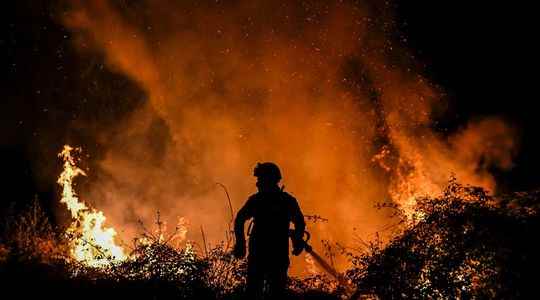The summer of 2022 has not yet said its last word, but the hour of reckoning has come. To what extent have the lands of the Old Continent been calcined? Unsurprisingly, the provisional toll of fires is increasing in the European Union with already more than 660,000 hectares burned since January, setting a record at this stage of the year since the start of satellite data in 2006.
Since January 1, fires have ravaged 662,776 hectares of forest in the European Union according to data updated on Sunday August 14 from European Forest Fire Information System (EFFIS)which has been keeping comparable statistics since 2006 thanks to satellite images from the European Copernicus program.
To view the graph, click here.
In the summer period alone, “2022 is already a record year,” EFFIS coordinator Jesus San-Miguel told AFP. The previous record for Europe dates from 2017, when 420,913 hectares went up in smoke on August 13, and 988,087 hectares in one year. “Hopefully we don’t have the October we had that year,” he continues. At that time, 400,000 hectares had been destroyed across Europe in one month.
To view the graph, click here.
Spain, the most burned European country
In terms of burnt areas, Spain takes first place in the sad ranking, with the disappearance of 246,278 hectares. The Iberian Peninsula dried up like France by several heat waves this summer was devastated by fires, mainly in Galicia in the northwest of the country.
Sunday August 14, it was the turn of the Aragon region, in the north of the country, to be ravaged by flames (8000 hectares affected). At the same time, the Vall d’Ebo, in the province of Alicante, suffered the same fate.
In second place comes Romania with 150,528 hectares burned, followed by Portugal (75,277 hectares). The southern European country has been battling a fire for more than a week in the UNESCO-recognized global geo-park in the region of the Serra da Estrela mountain, which rises to around 2,000 meters. While it has already reduced more than 17,000 hectares to dust, it was declared “under control” on the night of Friday to Saturday August 13.
To view the graph, click here.
Still on the side of burnt land, France comes in fourth position. Admittedly, France had worse years in the 1970s, before European standardized data. But the year 2022 is the most serious in sixteen years according to these figures. The two large successive fires in Gironde, in the south-west, have a lot to do with it. The resumption of fires in the region has destroyed more than 7,400 hectares since August 9.
Slovenia faces a historic fire
Western Europe is not the only one to have been nibbled by the flames: the fires have also caught certain countries of Eastern Europe by surprise. In July, it took more than ten days for firefighters to control the biggest fire in Slovenia’s recent history, helped by a population so mobilized that the government had to ask residents to stop donating to firefighters. In the west of the country, near the border with Italy, several villages had to be evacuated. Not having specialized planes to fight the fires, Slovenia had to call for help from Croatia, which sent a plane … before calling it back to extinguish its own flames, in Zaton, not far from Dubrovnik.
Also unaccustomed to fires, the German capital was affected by a large fire which broke out on Thursday August 4 from a police ammunition depot in a forest in the midst of drought. The fire was quickly brought under control. Until now spared by such fires, Berlin is today increasingly threatened because of the importance of its wooded areas (29,000 hectares of forest).
The exceptional drought in Europe, combined with heat waves, facilitates the outbreak of fires. Formerly reserved for countries bordering the Mediterranean Sea, fires are likely to multiply in our eastern neighbors due to the favorable climatic conditions for fire outbreaks. “This is exactly what happened in central Europe” hitherto spared by these meteorological phenomena, specifies Jesus San-Miguel.
If they are less impressive, the fires in this region are to be taken seriously: the Czech Republic saw a fire devastate more than a thousand hectares, which is little compared to other countries, but the surface burned is 158 times greater than the 2006-2021 average. If their burnt areas are still very small compared to the lands of the south, the Eastern States are beginning to arm themselves to prevent a new disaster. For example, the Slovenian government is now considering the acquisition of its first water bomber planes. Faced with global warming, the whole of Europe is now concerned.
